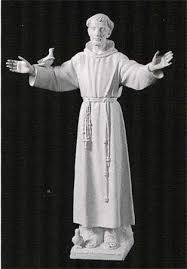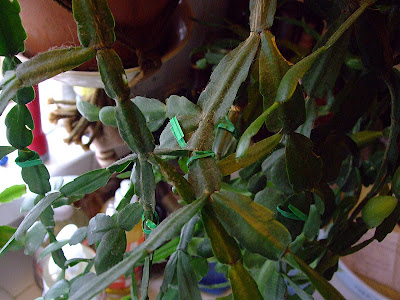My first job out of college, and the kick-start to my horticultural career, was at a local garden center. Among the flower pots, fertilizers, and bird seed was also a wide variety of garden art. Gazing globes, bird baths, springy butterflies on sticks, pinwheels, and of course, statues. Most of the statues were cute rabbits, turtles, fairies, and the like. But there was a particular type of statue that always struck me as an odd thing to automatically place in a garden: a statue of a monk holding a bird.
There weren't very many statues of this humble figure in our garden center, but there were a few people each year who would buy one. I guessed he was a saint of some kind, but not having grown up in the Catholic faith, I knew little of the importance surrounding this man. I later learned that this gentle monk was St. Francis of Assisi, the patron saint of gardeners animals and the environment. (but gardeners have claimed him, too.)
~~~~~~~
So, who was St. Francis of Assisi and how did he come to be the saint of gardeners? For that we need to travel all the way back to the 12th century. Giovanni di Bernardone was born in either 1181 or 1182 (did you notice that Francis wasn't even his real name? More on that in a bit.) to a wealthy cloth merchant in Assisi, Italy. As part of the upper class of society, young Giovanni enjoyed all the things life could bring him: fine clothes, rich friends, pleasures and distractions of every kind. Giovanni also developed a taste and enthusiasm for all things French. Because of this, and because he was also half-French (Pops was Italian, Mom was French) his father started calling him Francesco (which is Francis in English) - "the Frenchman." The name stuck.
In 1205, Francis left home to enlist in the army, but a strange vision instructed him to return home to Assisi. There has been much speculation as to what this vision was, but it marked a drastic lifestyle change for Francis. He gave up all his former pleasures, for which his friends mocked him. He spent more and more time alone, asking God for enlightenment. He started caring for lepers - a task that was viewed as a disgrace. On a pilgrimage to Rome, he begged at church doors on behalf of the poor. On a particular occasion while begging at a church near Assisi, Francis had another vision in which Christ told him, "Francis, Francis, go and repair My house which, as you can see, is falling into ruins." Immediately Francis sold some cloth from his father's store and gave the money to the priest of that church.
Obviously, Signore di Bernardone was less than thrilled about the unauthorized charity from his store. After much heated and bitter arguing, which included bringing the case before the bishop, Francis renounced his father, relinquished his potentially large inheritance, left home, and lived as a beggar in the countryside surrounding Assisi.
Francis would go on to improve many crumbling churches, preach the Gospel, crusade for the welfare of the poor, and many other accomplishments. Arguably his most enduring legacy is the monastic order he founded: the Franciscans. This order of monks has been in existence since Francis was granted permission by the Pope in 1210. To read more about Francis's religious work, click
here for the Wiki. (one more tidbit of trivia: Francis was the first to set up a three-dimensional Nativity scene, complete with live animals.)
~~~~~~~
Now, how does all this apply to gardening? Apparently Francis had a great love for nature. He believed that nature was the "mirror of God" and called all creatures his brothers and sisters. In addition to preaching the Gospel, he also taught that man is to protect nature and enjoy it as God's stewards and because we are creatures ourselves.
Many legends about Francis sprang up after his death in 1226. Many of these stories are the inspiration for the various poses of his statues. One tells of how, when Francis and his companions were walking, they came upon a grove of trees filled with birds. Francis told his friends, "Wait for me while I go and preach to my sisters the birds." As he spoke the birds gathered around him, drawn by his voice, and did not fly away.

This next story is a little hard for me to believe actually happened, but hey, it is a legend after all. A certain town in which Francis lived for a while was being terrorized by a wolf. This wolf would take the farmers' cattle, and even kill people. Francis saw the fear of the townspeople and decided to go speak to the wolf. On the way into the woods, his companions were overcome with fear and ran back to the town. Francis forged ahead on his mission. Upon finding the wolf, Francis made the sign of the cross, commanded the wolf to come to him and to hurt no one. The wolf came and laid down at Francis's feet. Francis made a pact with his brother wolf to no longer come into the town and take food by force. Instead, he led the wolf into the town - much to the alarm of the people - and explained that the wolf did these things out of hunger, and that the townspeople were to regularly feed the wolf. He even made a pact with the town dogs to not harass the wolf when he should come.
In my research for this post I ran across something rather interesting. Nearly all the paintings and statues (excepting garden statues) depict St. Francis with a halo and the
stigmata. The stigmata didn't appear until late 1224, and the halo is a symbol associated with his sainthood. Therefore any painting etc showing Francis with both the stigmata and the halo were made after his death.
But there is one particular painting that is perhaps the oldest known portrait of St. Francis. It is in
St. Benedict's Cave near St. Scholastica's Abbey in Subiaco, Italy. Francis stayed there in 1223-1224. While there, Francis posed for his portrait to be frescoed on the wall.
St. Francis still makes it into our modern culture (more so if you live in Europe where there are many Franciscan monasteries). In the movie
Ever After, the prince and Danielle travel to the local Franciscan monastery to see their "astonishing library." The city of San Francisco in California is Spanish for St. Francis. One of my local hospitals is St. Francis Regional Medical Center, and at their entrances and in their healing garden are, of course, statues of St. Francis.
So, after all of that, what does it mean to have a statue of St. Francis? Well, if you see one in a garden, it shows that that particular gardener is doing their part of caring for and enjoying nature. In the case of the hospital, it shows that they have chosen to care for the creatures known as humans.
If you happen to see a statue of a monk holding a bird and perhaps holding council with a wolf, let it serve as a reminder to always care for and enjoy nature and its creatures, great and small.
.JPG)
.JPG)
.JPG)
.JPG)
.JPG)
.JPG)
.JPG)
.JPG)
.JPG)
.JPG)
.JPG)
.JPG)





















.jpg)




